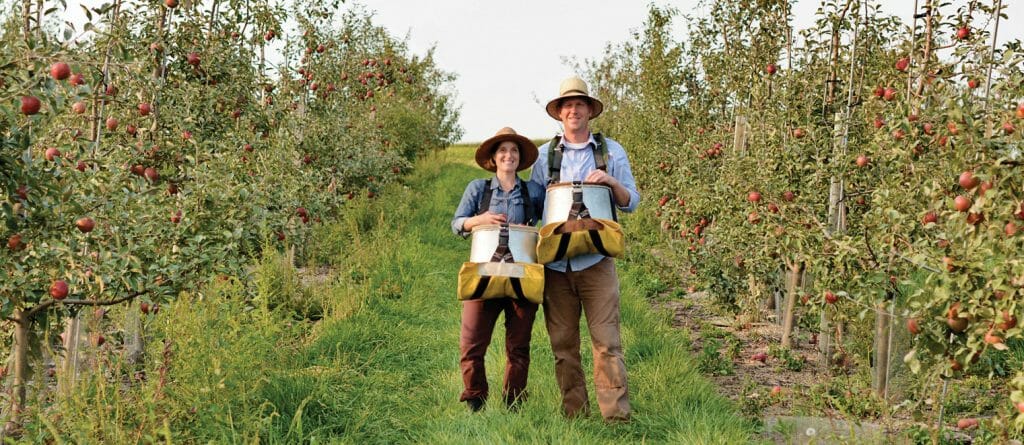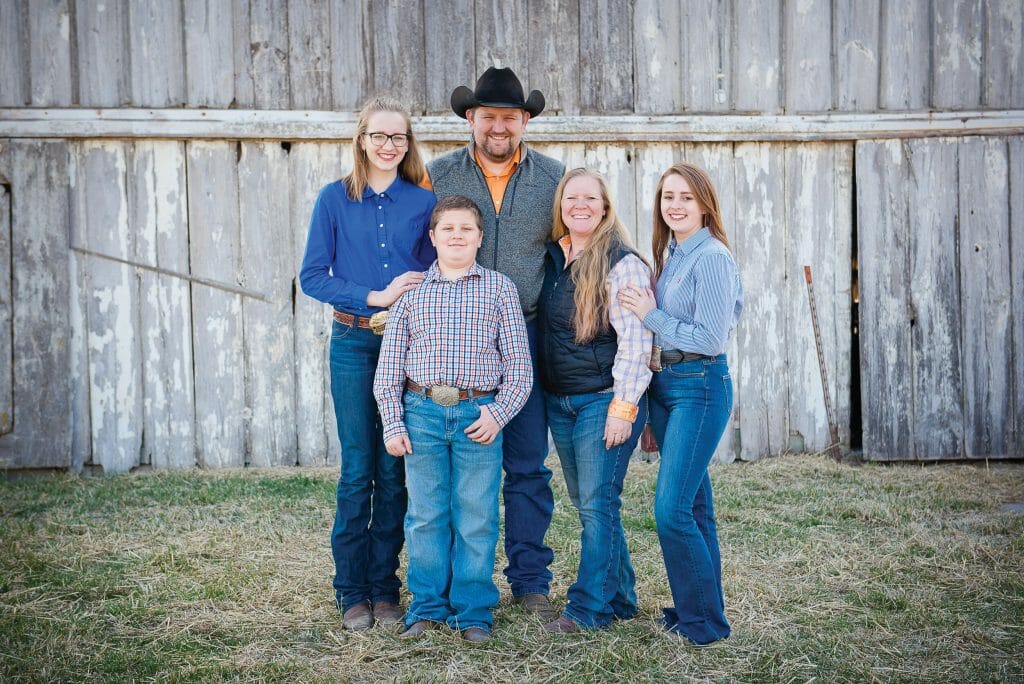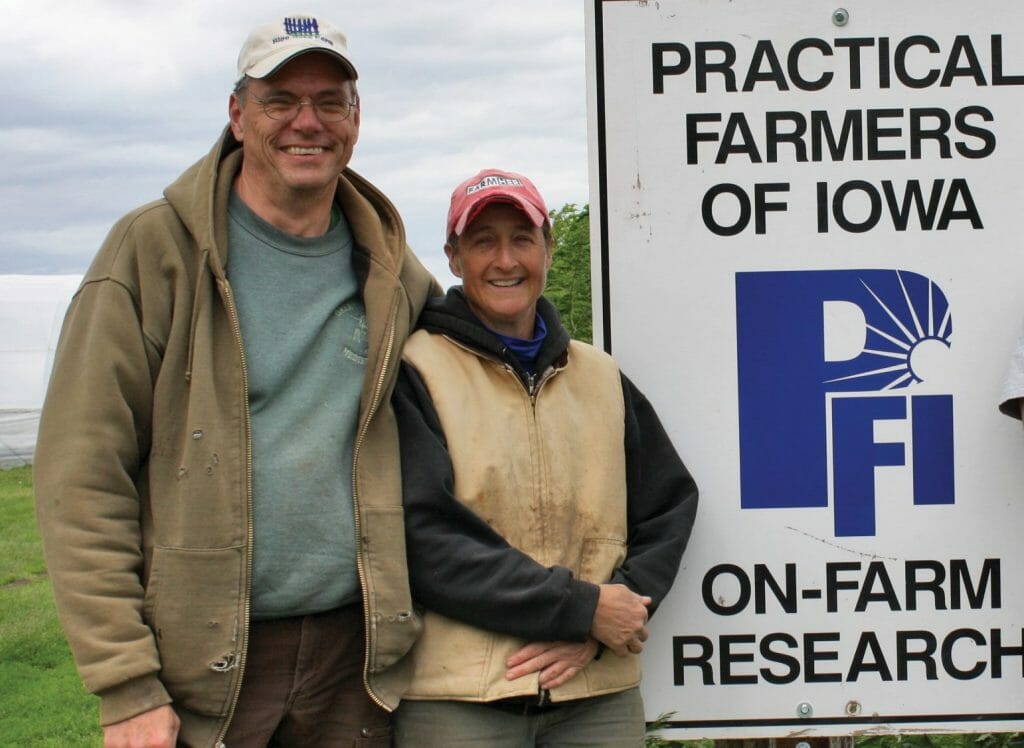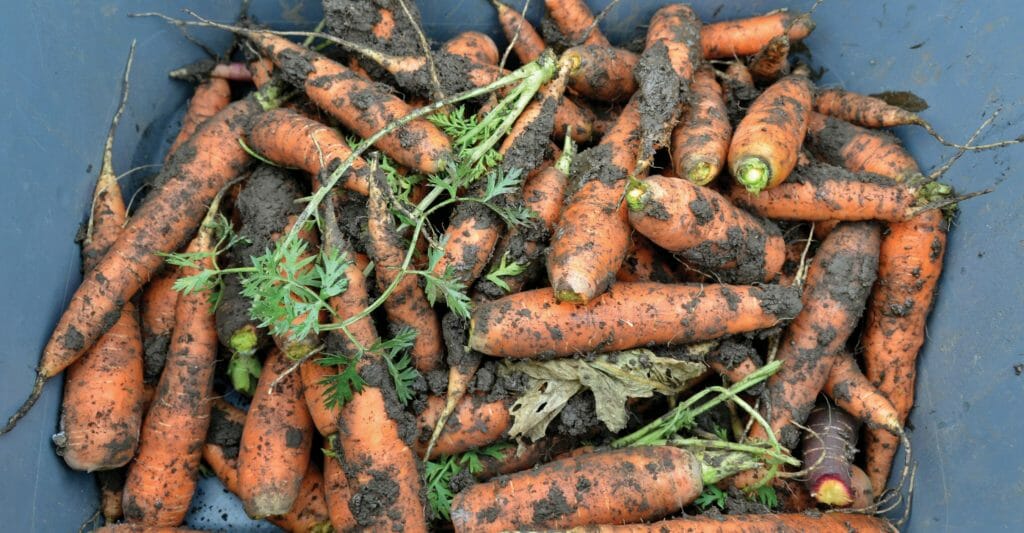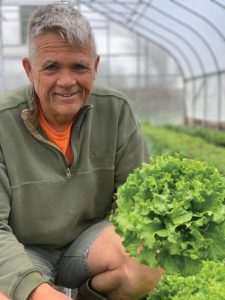Rising to a Local Foods Challenge
While the spring weather was unusually cooperative, a perfect storm was brewing to spike demand for local food. As we rolled through March, vegetable farmers were just starting to harvest early crops from their high tunnels and finish up their CSA sales for the season.
Suddenly, everyone was staying home, cooking, reducing their trips to the grocery store – and to some degree, panic-buying. They were also browsing social media like never before and finding local food near them. Through March, April and into May, we watched and listened as farmers’ CSAs sold out and waiting lists piled up. Meat producers ran short and booked more distant locker dates. And all types of direct-market farmers quickly created and implemented contact-free pick-up and pre-order options, and built collaborations with one another at an astonishing rate.
We had (and still have) a front-row seat to the resiliency – and necessity – of the local food system in action: a collection of highly competent and passionate growers who are rapidly adapting to provide food to their communities while keeping their farms, families, employees and customers safe during a pandemic.
We still need more diverse farms that grow food for Iowans, and they need consistent demand from consumers, institutions and grocery stores to keep their operations running. Right now, relatively few farmers are shouldering this surge in demand. Farmers are grateful to be selling more, but during the COVID-19 pandemic, they are dealing with the same risks and uncertainties of infection as the rest of the public, and putting in more hours to transform their businesses. And after they’ve sold all they have, they are replying to emails and phone calls, turning away customers seeking food.
“I feel guilty turning people away, but we already added 50% more shares and I can’t scale up faster than that,” says Carmen Black, of Local Harvest CSA near Solon. Caite Palmer, of Prairie’s Edge Farm near Castalia, says that managing sales right now is “like drinking out of a fire hose.”
Despite shouldering these extra burdens, local-food farmers are meeting the challenges with creativity and determination. In this article, we profile five farms and how they have responded to rising interest in and need for local food during the pandemic: Shanen Ebersole of Ebersole Cattle Company; Jill Beebout of Blue Gate Farm; Emma and Marcus Johnson of Buffalo Ridge Orchard; Maren and Tom Beard of Luna Valley Farm; and John and Janna Wesselius of The Cornucopia Farm.
So many more farmers than we have space to profile here are impressing us with their capacity to adapt, and their drive to continue to grow and deliver safe food. To see what other direct-market farmers are up to, browse their links through PFI’s local foods webpage.
Expanding Reach Through a Regional Farm Collaboration
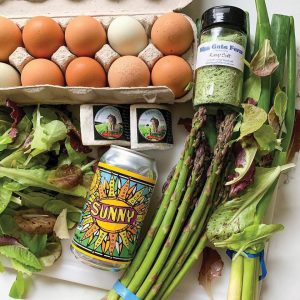
An example of a collaboration box filled with fresh goods from Shanon Ebersole, Jill Beebout, Lost Lake Farm and Peace Tree Brewery. Photo courtesy of Peace Tree Brewery.
Shanen Ebersole is a cattle rancher, operating Ebersole Cattle Company with her family near Kellerton. Jill Beebout raises vegetables with her husband, Sean Skeehan, at Blue Gate Farm near Chariton. The two women have been vending alongside one another for years at the Des Moines Downtown Farmers’ Market and experience a lot of crossover in customers due to offering complementary products. Several years ago, Jill transitioned her winter vegetable CSA into VegEmail, an online order form through Google emailed out weekly, where customers order a la carte and pick up locally on Saturdays.
Jill invited Shanen to sell her beef via this platform, to help round out product offerings. During the unexpected hiatus from the Downtown Farmers’ Market, Shanen and Jill partnered with Lost Lake Farm, operated by Kevin and Ranae Dietzel near Jewell, and Peace Tree Brewery to provide customers a safe, one-stop, “stay-in-your-car” shop.
“We were lucky to have this system in place prior to the pandemic so we weren’t scrambling, just fine-tuning, and had an established email list that we could build on,” Jill says. “Our customers drive up and have eggs, vegetables, meat, cheese and beer dropped in their vehicles. We more than doubled sales [in March and April]. Our main driver was egg sales, and existing customers were buying extra eggs. We were in the right place at the right time.”
Shanen’s beef sales tripled. “Joining Jill’s VegEmail has been a very good thing for our ranch,” she says. “It has allowed us to expand our customer base, and helps Jill’s customers have a more well-rounded grocery shopping option besides the grocery store.” Shanen adds that she believes regional collaboration is the future of local foods. “Work with a farmer or rancher who has the same values as you do, the same quality of product and is in a similar geographic area,” she says. “The key to our growing success is to add a fuller basket with similar quality products. We can work together because we’re complementary to each other.”
Adapting Sales to Put Safety First
Emma and Marcus Johnson run Buffalo Ridge Orchard with Emma’s parents, Vernon and Mary Zahradnik, near Central City. Their 2020 season was unique from the start, beginning with a patch of black ice on New Year’s Eve that left their car rolled and Emma with several broken vertebrae. “That crash put a lot in perspective for us,” Emma says. “My parents are critical to our farm operation. They both work on the farm and go to farmers markets, but they are both in their 70s. The farm is important, but some things are more important than the farm, like our family’s health.”
“Our goal in everything we’re doing is safety first. It would be great if our business can make it through. In the end, everyone’s health is more important.”
– Emma Johnson
The 80-acre farm has 5 acres of diversified vegetables in the field and high tunnels, and 13 acres of orchard, including 4,500 apple trees. In a typical year, Buffalo Ridge Orchard runs a CSA, sells at five farmers markets and does a large volume of sales to wholesale accounts including grocers and institutions. The orchard is poised for a big change in 2020: the full launch of their newly built on-farm store.
Due to COVID-19, however, they did not feel comfortable opening the store to the public in May, as they had planned. “Our biggest worry was getting my parents sick, or our workers sick,” Emma says. “Our goal in everything we’re doing is safety first. It would be great if our business can make it through. In the end, everyone’s health is more important.”
In the spring, the family primarily sells leafy greens to institutions and farmers markets; their CSA doesn’t typically start until August, when the apple harvest begins. “We needed to move spring vegetables during May without farmers markets, but we weren’t sure if we could successfully do a share box that only had leafy greens,” Emma says. “So we decided to reach out to some other growers and put together a monthly box share, with a box delivered, or picked up on the farm each week.
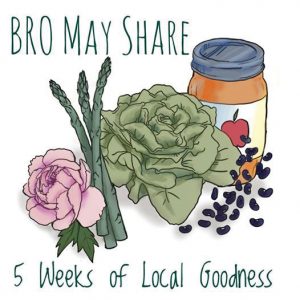 “We knew a farmer with organic asparagus who was looking for an outlet to sell it. That worked. We bought black beans from Jason Grimm and added them to our share. Over the Moon Flower Farm, who is also growing some flowers here, added early spring perennial flowers.”
“We knew a farmer with organic asparagus who was looking for an outlet to sell it. That worked. We bought black beans from Jason Grimm and added them to our share. Over the Moon Flower Farm, who is also growing some flowers here, added early spring perennial flowers.”
The Johnsons already had a website set up for customers to purchase CSA shares, and Emma had spent time over the winter making it more user-friendly. “It turned out to be time well spent,” she says. “I’m not a high-echelon web designer; I’m just happy if it’s working. We upgraded our plug-in for the WordPress e-store, which has been nice for loading many more products, including all of our herb plants and share boxes.”
Buffalo Ridge Orchard plans to continue collaborating on boxes through July and is participating in online and drive-through markets with Iowa City and Cedar Rapids farmers markets. In August, the apple harvest begins, and so does the family’s CSA. As some farmers markets begin to open for in-person shopping, the Johnsons are still weighing the pros and cons of their marketing choices. “We’re like everyone else right now – just trying to figure it out as we go along,” Emma says. “Every day something changes.”
Adding Value to Serve Local Consumers
Maren and Tom Beard own Luna Valley Farm near Decorah. They operate a diversified crop and pastured-livestock farm and specialize in agritourism through hosting pizza nights and glamping (glamorous camping). In mid-March, they decided to make a quick shift. Their freezers were stocked with meat destined to sell during pizza nights in the summer. Maren recalls asking Tom: “People are home and want something exciting to brighten up their week. What can we do that will also help other small farms and businesses?”
The Beards put together local food boxes – which they called the “Rural Resilience Box” and the “Staples Box” – featuring Luna Valley Farm meat and vegetables from other local growers. “A key part of this program is giving people the option to add additional provisions to their order,” Maren says. “We have so many other small farms and local businesses that we love and thought it would be great to partner. Customers are able to add local beer, wine, dairy, honey, yeast, microgreens and locally roasted coffee. We’re helping other businesses move product.”
Collaborating businesses drop their products off at Luna Valley Farm, which the Beards sort out in their commercial kitchen. Maren and Tom provide no-contact delivery to customers’ doorsteps and have recently expanded to offer a farm pick-up option.
“Something I found interesting is that probably two-thirds of our customers have never bought meat from us before, so that’s kind of cool,” Maren says. “We feel pretty lucky that we are in the business of selling food, because people need food. I think the pivot towards buying something locally feels pretty good [to them] and is a natural fit in their grocery budget.”
In June, Luna Valley Farm started offering pizza for takeout, which have been selling out in a matter of hours. In July, the farm started offering distanced dining in their pastures, allowing for community gathering while adhering to safety guidelines. . Maren and Tom also decided to honor their glamping reservations for the season, and Maren says they’re “coming up with strategies for how to safely host people.”
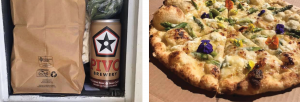
Left: The Beard’s Staples Box Delivery, featuring meat from Luna Valley Farm, vegetables from local growers, and beer from Pivo Brewery in Decorah.
Farmer-Led Updates to the Farmers Market
John and Janna Wesselius own and operate The Cornucopia Farm near Sioux Center. They raise several acres of produce in the field and in two high tunnels, and raise pastured broilers and Berkshire pigs. During a typical year they run a CSA, sell at the Falls Park (Sioux Falls), Sioux City and Sioux Center farmers markets, and do a fairly high volume of sales to local colleges, restaurants and other institutions.
John is the chair of the Falls Park Farmers Market board. Starting in early February, the market vendors and board started weekly conference calls to figure out what they would do about the market during the pandemic. “We were proactive about talking with the city and city health department early,” John says. “We were watching what farmers markets in the south and east were doing, since their market seasons had already started.”
The Falls Park market decided to pilot a pre-order, drive-through market, bringing other vendors in as the wrinkles were smoothed. The market also kept 10% of vendors’ drive-through sales to cover overhead, including web hosting and payment processing. They began with five vendors and over the first several Saturdays amassed $30,000 in sales. By late April, 14 of the 30 vendors were participating in the online ordering and drive-through market.
By the time the market was ready to integrate in-person shopping in May, the vendors were confident and happy with the new systems, which had pre-order pick-up from 8-10 a.m., and an in-person market from 8 a.m. to 1 p.m. “I’m hoping to have half of my sales through online pre-orders and the other half through in-person farmers markets,” John says. “I haven’t increased my overall volume, but had a lot of volume to switch from other markets, like the college.”
Not all farmers markets transitioned as quickly to help farmers move early-season produce. To boost their early sales at The Cornucopia, John and Janna worked with local businesses to have pre-order drop sites in Sioux Center (The Fruited Plain), Le Mars (Red’s Printing) and Sioux City (farmers market location). “Mostly, those early sales were totally sold out,” John says. “We sold ‘Spring Goodness Bags’ with a mix of spring produce, and each time sold out of our 50-bag capacity at $25 per bag.”
For their farm’s online ordering system, which is separate from the Falls Park Farmers Market, John uses Local Line, based in Ontario, Canada (localline.ca). “We find it easier to use,” John says. “We like the catalog experience better for the customer and it integrates well with our social media. I also like that it has a $49 monthly fee regardless of sales volume. This works out to $12.50 per week.” Many online stores, including those created directly for farmers, charge between 2% and 10% per transaction. “Unless I was below $600 in weekly sales,” John says, “the flat rate is better for me.”
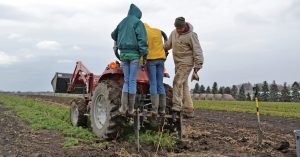
John Wesselius and some seasonal employees demonstrate how to harvest carrots during his 2018 field day.
Building Relationships in a Digital World
John offers one point of advice for other growers: Have your face visible in your social media if your customers are used to seeing you in person. “My customers are used to seeing me every week, but they don’t know my farm name, which is very common,” he explains. “They buy from the guy with the ugly mug and awkward manners, and they remember how I talk about my products.”
“During the drive-through market, one lady hollers at me, ‘Hey you, what’s your farm name? I like to buy lettuce from you and I bought the wrong stuff this week.’ So, I had a worker take a picture of me with a head of lettuce and it’s the most popular Facebook post we’ve ever had. Sales are relationship-based, and you need to communicate differently online than you do in person.”
Like the Johnsons at Buffalo Ridge, John and Janna are incurring higher costs associated with changing their sales from wholesale to retail, particularly in labor to pack smaller units, update the web store and process and organize orders. “We expect to have a larger payroll in 2020 by at least 1 full-time equivalent,” John says. But even with the challenges and higher costs, John sees this as a potential opportunity for lasting change.
“It’s too early to know the future. My hope is that people become more aware of local food and its role in food security. I hope people will look more reliably to local producers for produce, meat and eggs. I’m still a cranky old codger, but I really believe we will come out of this stronger and better suited to reach consumers directly. A year ago, I never would have believed I’d be selling half my produce online. I love cash. Customers that bring hundred-dollar bills? Those customers are keepers. But you need to be alert enough to be able to adjust. If we can do that, I think small farmers have an opportunity to come out of this ahead.”
- Maren & Tom Beard | Luna Valley Farm | Decorah
- Jill Beebout | Blue Gate Farm | Chariton
- Shanen Ebersole | Ebersole Cattle Company | Kellerton
- Emma & Marcus Johnson | Buffalo Ridge Orchard | Central City
- Caite Palmer | Prairie’s Edge Farm | Castalia
- John & Janna Wesselius | The Cornucopia Farm | Sioux Center
If you are interested in purchasing food raised on PFI-member farms, our local food directory can help you find farmers near you.


